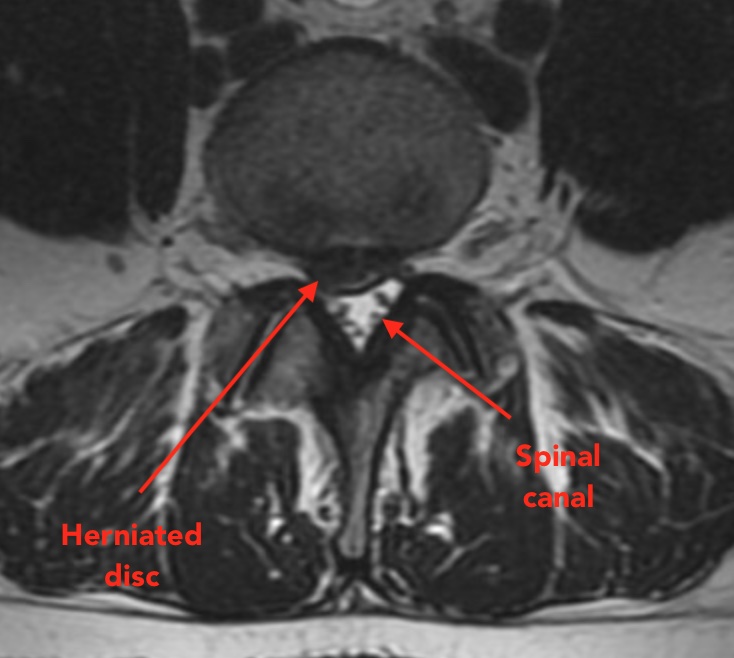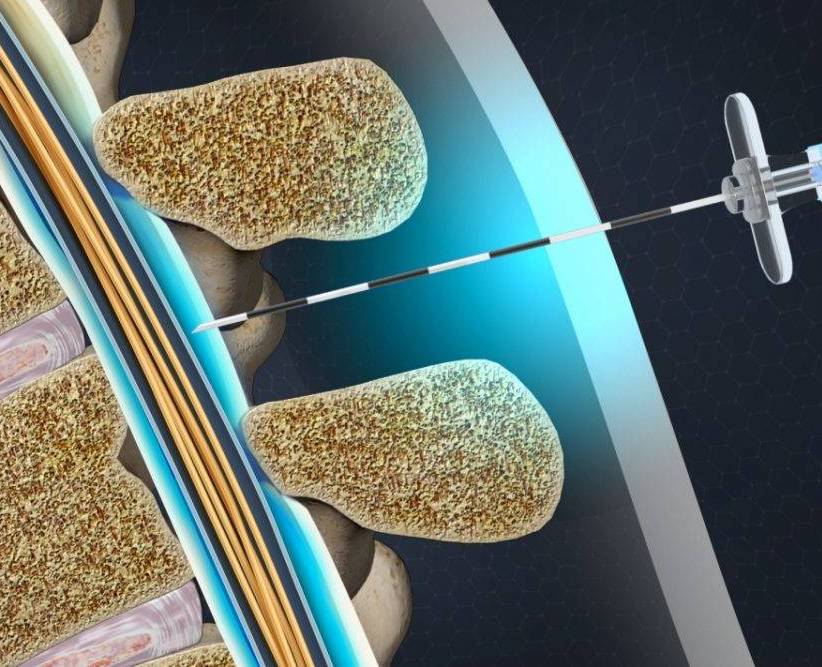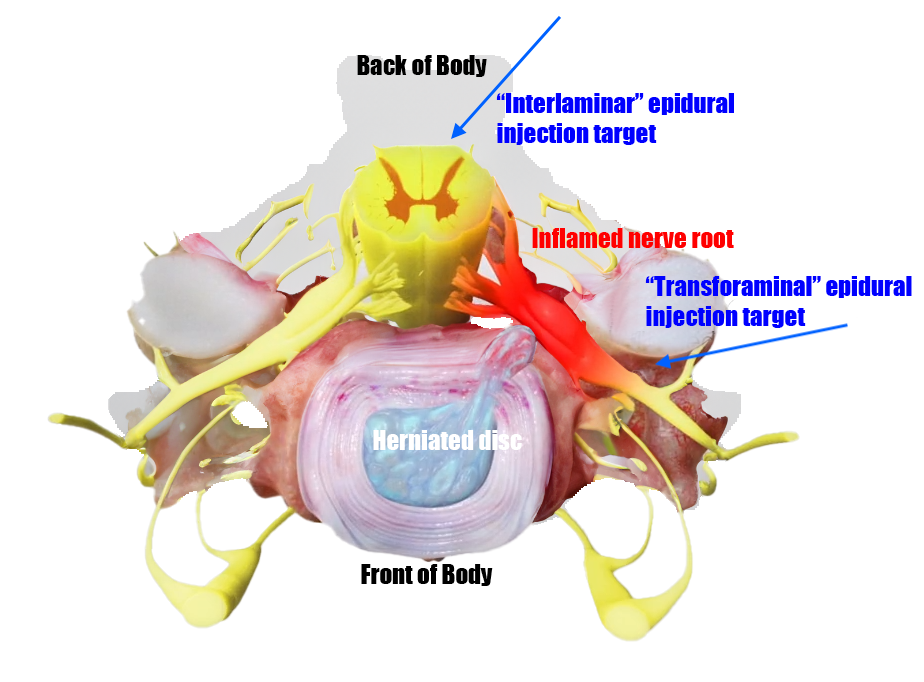Welcome to Portland Pain Solutions!
Epidural Steroid Injections
Epidural Steroid Injections
Epidural steroid injections are used to treat irritated or compressed nerves where they originate from the spine.

Spinal nerve roots can become irritated or compressed by protruding disc material, or narrowing of the spinal canal or passageways for the nerves to exit the spine.
Epidural steroid injections are performed under x-ray guidance, and use a small needle to access the tissue layer that lies between the protruding disc material, or narrowed vertebral bones, and the nerve root sleeves. This is called the "epidural space" because it is outside the "dura", or protective sheath that contains the nerves and spinal cord.


Epidural steroid injections likely work to treat pain by decreasing swelling in the irritated nerve roots, thus shrinking them and removing some of the excess pressure that results from that irritation. Another mechanism that I strongly suspect is the hydrostatic effect of pressurizing the space around the nerve root, thus breaking up adhesion between the inflamed tissues and leaving more room for the nerve root sleeve. The degree to which we pressurize this space can be adjusted by using more or less volume with the injection.
Frequently Asked Questions
Neck and radiating arm pain, or back and radiating leg pain respond best. Pure neck or back pain without radiation to the extremity is less likely to respond to an epidural injection, therefore in those cases we are more likely to try other techniques first.
It's usually a quick 5 minute procedure. Patients with complex spinal disease having more technically challenging injection placements may take 10-20 minutes.
For most patients, it's not a painful procedure. It's normal to feel pressure down the arm (for neck procedures), or leg (for back procedures) when we inject medication into the epidural space. The pressure sensation can be helpful from a diagnostic point of view. If the injection reproduces pressure where you ordinarily have pain, that helps to confirm the diagnosis.
We do our injections under x-ray guidance and follow the most up-to-date protocols in the medical literature to maximize safetly. Injuries are exceedingly rare, but possible, and generally avoidable by using appropriate technique and safety checks. Dr. Littlejohn has never had any serious complications of an epidural injection.
Onset of effect is generally 2-3 days, with maximum relief at 2 weeks.
This is quite variable between patients and it's hard to give an accurate estimate. If a patient is doing well at two weeks, relief may continue for months or even years.
We plan on doing the first injection, and then assessing response at two weeks before deciding on further injections. If a patient achieves 75%+ pain relief with the first injection, it's wise to wait and watch at that point. Patients having 25-50% improvement may benefit from another injection to see if 75% or more is possible. If a patient has less than 25% pain relief, we need to re-evaluate the problem and look for a better approach.
All insurances cover epidural steroid injections, however they have restrictions that differ from plan to plan. Many will require prior-authorization which means the procedure can not be done on the same day that you're evaluated.
Epidural injections can be done by three major routes. The most common would be the "inter-laminar" approach, which goes between the posterior bones of the vertebrae. This is how a labor epidural is performed. The "caudal" approach is another approach specific to back and leg pain. This is done at the bottom of the sacrum (top of the "crack"), where there is a small gap in the bones. Finally, the "transforaminal" approach is performed by placing a needle in the lateral part of the vertebrae where the nerves actually exit the spine. We usually start with the simpler interlaminar or caudal techniques and reserve the transforaminal apprach for cases not responding adequately to the initial injection.
Patient Experiences

“This [stellate block] has been a game changer for me… I hope more people will learn about this treatment for PTSD. ”
Casey Lavoie
Millinocket, ME

“Dr. Littlejohn gave me an epidural, it’s changed my life considerably... I’m 90% better.
”
Cheryl Cummings Lailer
Hancock, ME

“I've been suffering from generalized anxiety for most of my life.. I was so astounded by the relief from SGB therapy.”
Mindy
New Hampshire

“Before the (stellate) block I felt this shaking inside from PTSD... it stopped immediately after the block. I feel peace within my soul.”
Jennifer H
Maine

“I’ve been totally pain free for a year now… I’m extremely happy and satisfied.”
Judy Gallant
Millinocket, ME

“I was having debilitating headaches 4-5 times per week… the pain relief has been 75% or more.
”
Kelley M
Maine

“Having stellate shots changed my life.
”
Valerie
Connecticut

“Dr. Littlejohn has touched my heart… I’ve never had a doctor that I’ve loved so much.
”
Linda Levasseur
Houlton, ME

“Dr. Littlejohn opened up a new world for me, he made me feel young again.
”
Lois Gopin
Bangor, ME

“Dr. Littlejohn prescribed [a unique treatment option] a year ago… I feel 100% better.”
Margaret Staples
Norway, ME

“Dr. Littlejohn has been my miracle worker… He gave me back movement and pleasure with life… it’s been wonderful for three years now.”
Mary M. Bosley
Bangor, ME

“Dr. Littlejohn is without a doubt a miracle worker… he’s made me the person I want to be.
”
Michael Buckley Knox, Maine

“To walk out of the office pain free after ten years of dealing with this has been a wonderful feeling.
”
Mike McCarron
Hartford, ME

“The pain was so bad I couldn’t sleep, walk, or sit... I tried the shot and after 4-5 days the pain in my back totally went away.”
Stan Crossman
Winterport, ME
© 2021 Portland Pain Solutions | All rights reserved.
Most Insurances Accepted
Powered By: YES IT Labs L.L.C